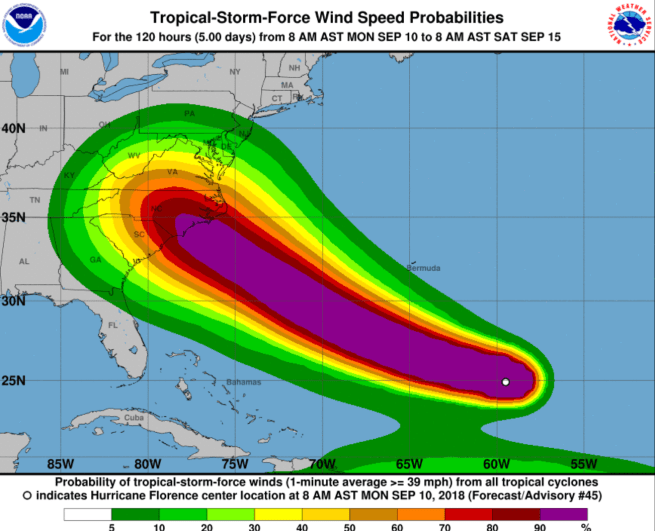
National Hurricane Center
Hurricane Florence is intensifying in the Atlantic Ocean and is now a Category 4 storm, according to the National Hurricane Center. As of mid-day on Monday, Florence was located more than 1,200 miles east-southeast of Cape Fear, North Carolina, moving to the west. The current projected path takes Florence toward the U.S. coast, and has her making landfall in North Carolina in the afternoon on Thursday, September 13.
The GFS Model Keeps Florence Just Offshore, Hugging the Coast of North Carolina
The latest GFS model shows Florence staying just offshore, bringing massive amounts of rain and heavy winds to the coast. If the GFS model turns out to be the storm’s correct path, the coast will be the most impacted area. You can see the latest GFS model below.
“Data from a NOAA Hurricane Hunter indicate that Florence has continued to rapidly strengthen and has maximum sustained winds near 130 mph,” the National Hurricane Center tweeted around 11:30 a.m. Eastern on Monday.
Florence Is Expected to Be a Category 3 or 4 When She Makes Landfall
Meteorologists expect Hurricane Florence to be a Category 3 or a Category 4 storm when she makes landfall in North Carolina.
A Category 3 storm is characterized as a major hurricane. It brings with it winds of 111 – 129 miles per hour.
“Well-built framed homes may incur major damage or removal of roof decking and gable ends. Many trees will be snapped or uprooted, blocking numerous roads. Electricity and water will be unavailable for several days to weeks after the storm passes,” reads the Saffir-Simpson Hurricane Wind Scale.
A Category 4 storm is also characterized as a major hurricane. Wind speeds are higher — in the 130-156 mile-per-hour range.
“Well-built framed homes can sustain severe damage with loss of most of the roof structure and/or some exterior walls. Most trees will be snapped or uprooted and power poles downed. Fallen trees and power poles will isolate residential areas. Power outages will last weeks to possibly months. Most of the area will be uninhabitable for weeks or months,” the Saffir-Simpson Hurricane Wind Scale notes.

If this is a Category 4 storm, it will be the fourth in history to ever make landfall north of Georgia (Hugo was in 1989, Gracie was in 1959, and Hazel was in 1954).
Florence Will Bring Heavy Rains & High Winds to North Carolina, South Carolina & Virginia
Florence is expected to bring heavy rain along the coast of the Carolinas, but several towns located inland are expected to see a lot of rain. The heavy rain threat could last for days if Florence stalls. This could cause disastrous flooding in several areas.